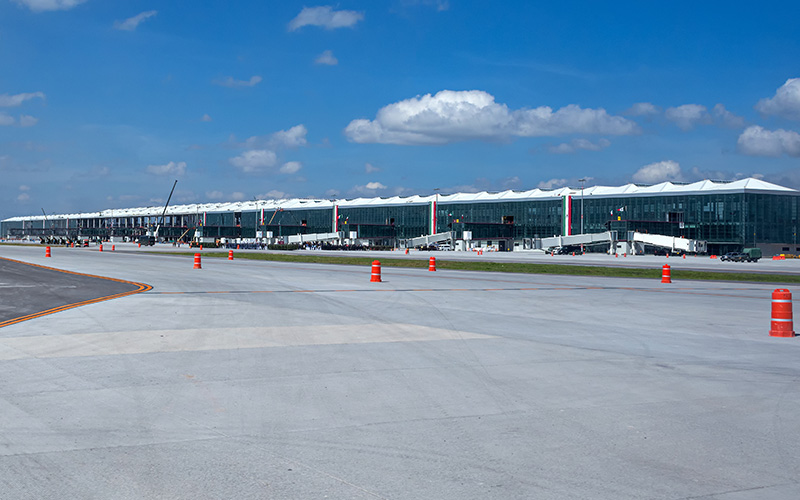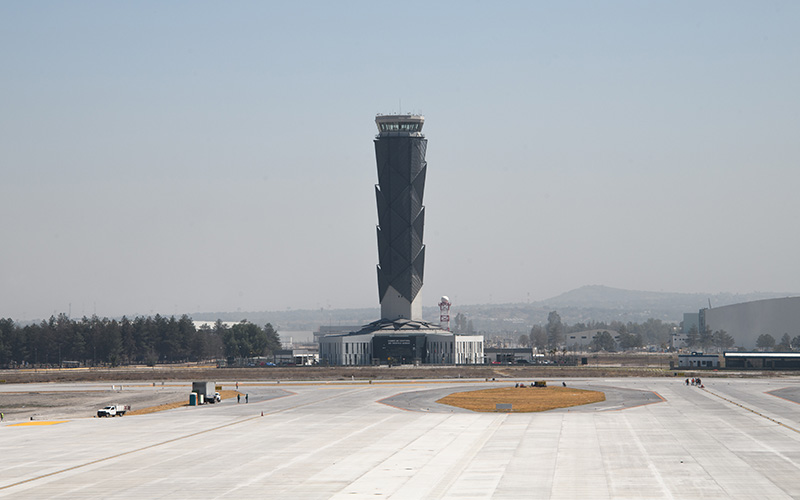It may not be the news that anyone expected, probably least of all the cargo-only operators that use Benito Juárez International Airport, or MEX – Mexico City’s international airport. But back in February, Mexican President Andrés Manuel López Obrador issued a decree banning cargo-only flights from MEX, in an attempt to reduce flight congestion at what is South America’s busiest airport. The plan is to move all cargo-only carriers to the new international airport in the region, Felipe Angeles International Airport, or NLU in IATA parlance. From July, that is where Cathay Cargo will operate its freighters.
NLU is one of López Obrador’s pet infrastructure projects, and part of his government’s austerity drive, which includes selling his predecessor’s presidential Boeing 787 and flying commercial. Similarly, López Obrador decided against realising the vision of the previous incumbent: a massive Norman Foster-designed airport that was being built on marshland south of NLU and just north of MEX. The view of the new government was that not only was the project mired in soft ground, but also by escalating costs and corruption. A referendum was held on its future and many thought the money could be better spent.
‘It was going to be a six-runway airport hub with more than 100 gates,’ says Fernando Dragonne, Cathay Cargo’s Area Cargo Manager, Western US. ‘But he decided to shut it down, even though it was 32 per cent completed. Instead of having one airport and shutting all of the others in the vicinity, he decided to create a multi-airport system. And NLU is the newest and latest.’

Cargo first at NLU airport
NLU fits better with López Obrador’s economic vision. He deployed the armed forces to extend and develop the existing military facility that NLU is built around – and will do the same for the two regional hospitals that will be built using the funds from the sale of the 787. While the airport is now complete, the transport infrastructure and links to the city centre – some 40km away – are yet not. For now, the cargo carriers will be the first long-term tenants at NLU.
‘On the passenger side, it’s a 14-gate small airport,’ says Dragonne. ‘It’s mainly domestic with three international routes to the Dominican Republic, Venezuela and Panama at the moment.’
For cargo, the layout is similar to MEX, but ‘newer, bigger and better.’ There is more space for the airport vehicles towing cargo, and the new warehouse is close to a dedicated cargo platform that can accommodate five Boeing 747 freighters. ‘The only downside is that they built in the same limitation as at MEX, which is to put a fence too close to the aircraft parking area. So for cargo aircraft with a nose door this impedes operations a bit. But the rest is bigger and better.’
So what happens now? As Camilo Gallo, Area Cargo Manager, Miami and Offline, explains, ‘we’re working now on establishing a continuity business plan to make sure that we have a smooth move, and that we have the proper tools and the proper suppliers in place to be able to support the move.’

Working to a tight timeframe
This is quite an undertaking. The initial decree gave cargo carriers 90 days to transfer operations, which was extended to more than 100 days after IATA and airlines complained. But there’s still a lot to consider: to which airport should cargo agents tender cargo? And what should be done with cargo for Cathay Cargo that arrives in MEX in passenger bellies from across South America? Then there is the compliance and paperwork for switching airports to fulfil with regulators and authorities, plus the nitty-gritty involved in flying to the new base.
Lori Shaw is Cathay Pacific’s Head of Regulatory Affairs in its Flight Operations Team. ‘Flight Operations assesses the airport and looks at its complexity,’ she says.
NLU, like MEX, is both ‘hot and high’, and will follow the same training profile as previously provided for Mexico City. Cathay captains may operate to NLU after competency has been established by physical entry – an actual landing – and a simulator exercise. This competency is valid for 12 months and is revalidated by the Line Operations team by physical entry, an audio-visual presentation, self-briefing or a simulator exercise.
‘The crew will review the approach plates, in addition our Line Operations team will provide what we call a “port page”, which is a briefing about the airport based on its characteristics such as runway lengths, available approaches and expected weather conditions,’ adds Shaw. ‘This information will be loaded to the flight crew iPads.’
Flight crew do not usually lay over in MEX, but contingencies for both Engineering in terms of resources and accommodation for pilots need to be in place should an aircraft have a technical issue. Then the pilots’ iPads require connectivity, and all parties need access to an office. Teams from across the business are attending to myriad components. The AOC (air operator’s certificate) for the new port is close to being signed off, the same suppliers that work with Cathay Cargo at MEX will continue at NLU, and bit by bit all the inspections, paperwork in both Mexico and Hong Kong’s CAD (Civil Aviation Department) are being concluded.
‘We are working to ensure that the warehouse is compliant with our requirements, in terms of health and safety, that we have an x-ray machine, that we have a cool room, a strong room and an office space for our personnel,’ says Dragonne. ‘We are working with the warehouse and then we will have a few folks from Hong Kong come and do pre-assessments prior to the switch and the signing of the contracts.’
What will the airport move mean for Cargo customers?
The signs are encouraging for Cathay, but what will it mean for cargo customers? One major decision has already been made. Cargo derived from Mexico will be only be accepted at NLU once it becomes operational. However, cargo that arrives from across South America in the bellies of passenger aircraft at MEX will be trucked between airports. This, outside of seasonal peaks for perishables, accounts for about 15 to 20 per cent of Mexico City’s cargo tonnage for Cathay Cargo.
‘We are only going to truck transit cargo,’ confirms Dragonne. ‘We’re planning to have this transit cargo delivered to the arriving carrier’s warehouse at MEX. They will be tendering our cargo out to a trucking company, which will move it to tender to us at the new warehouse at NLU.’
The cargo practicalities for perishables
If this sounds a lengthy process, it’s comparable to timings in practice now. ‘Our cargo often waits for different reasons, but mainly because for the arrival of the inbound flight and the departure of our flight,’ he adds. ‘Sometimes, it can be around 12 hours. If we have a perishables shipment, it’s stored in a cool chamber until it’s ready to be delivered or transferred. When it’s transferred, it’s again put in a cool room, until it is time to be built up. It will be basically the same but we will need refrigerated trucks for the journey and we are already working on that.’
So far the team is pleased with progress and looking forward to working at the new facility once everything is ironed out. ‘We may have been affected by this move,’ adds Gallo, ‘but I do feel that the infrastructure at NLU is better. There are bigger warehouses, we have space to move and grow and we’re going to continue to feed Mexico with Latin America cargo, move it on to Hong Kong, and we will use the remaining weeks to ensure that we have all the proper tools we need to be able to do that.’









